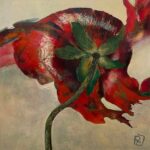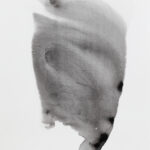SALLY BROKENSHA – “We have art in order not to die of the truth” ~Nietzsche
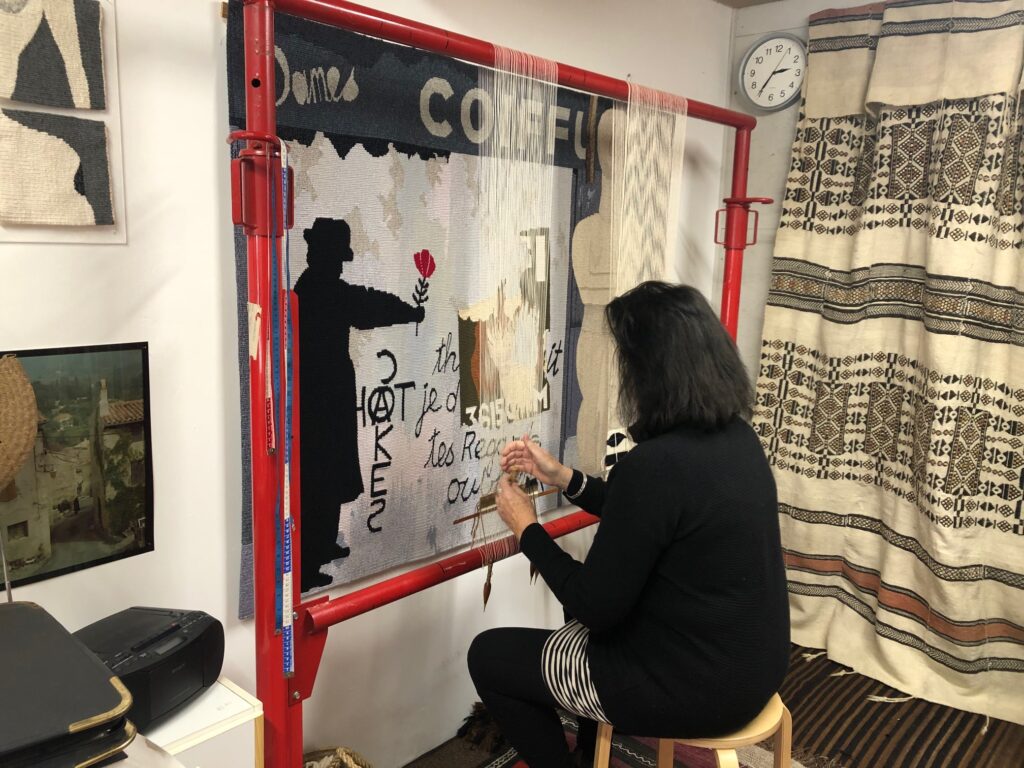
I recently wrote a blog about Deborah Maurice, a Scottish puppeteer, who lives just a short distance away from my place. It was Deborah who told me about Sally Brokensha an Australian textile artist, and she strongly recommended I get in touch with her as her work, she said, was well worth the while for one of my next blog posts. Sally also lives nearby. That’s the extraordinary thing about the Drôme, whichever direction the compass needle points you are sure to come across good artists, French and foreign. “They are all over the place” a friend once remarked. I contacted Sally and we made an appointment. Deborah was right. Sally proved to be a most interesting person, whose life path is slightly dizzying, as well as being an artist.
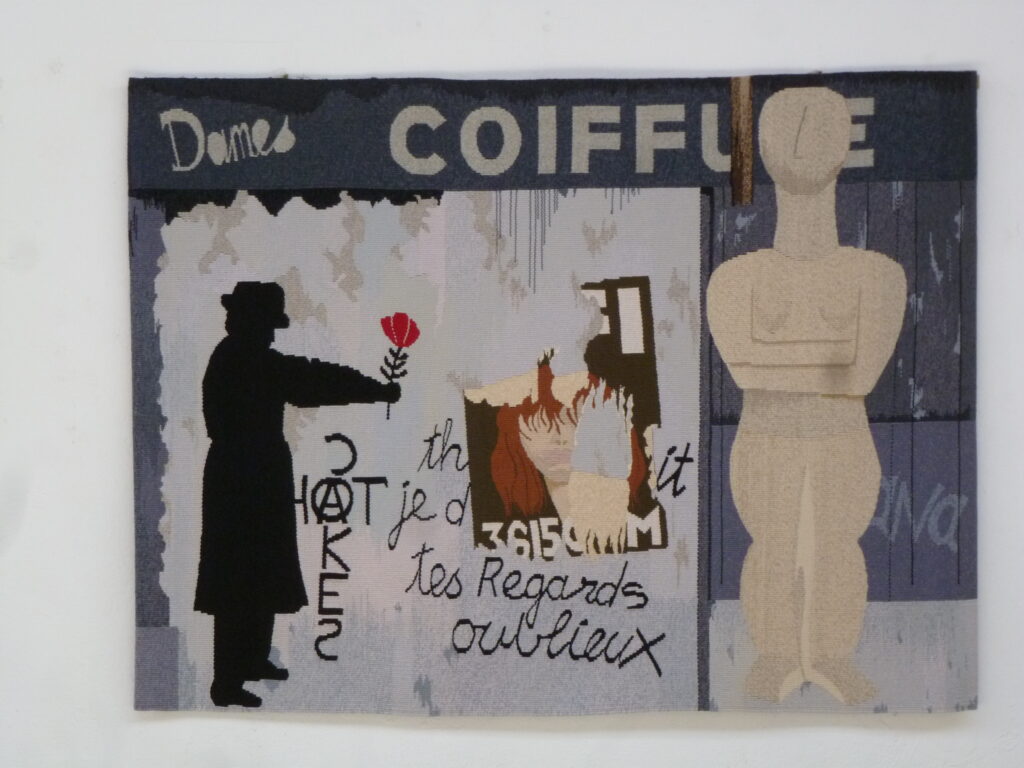
Mal à propos, 170 x 126cm – woven tapestry, cotton, wool
Textile art? I was not quite sure what it actually encompasses. I have some beautiful kilims in my home that could easily pass for abstract paintings if I framed them and hung them on a wall. However, most people wouldn’t consider them to be works of art. On the contrary the famous 10th century Bayeux tapestry in Caen is an embroidered piece that measures 70 metres in length -with scenes that celebrate the battle of Hastings that hails the conquest of England- is an exceptional piece of art. Museums all over the world house collections of wonderful tapestries such as the Apocalypse Tapestries in Angers and I remember being awed by the stunning 15th century tapestry of The Hunt of the Unicorn at the Cloisters Museum in New York that had been woven by Flemish weavers, who were famous during the Renaissance and worked from cartoons by painters from all over Europe. In the 20th century numerous artists such as Picasso, Matisse, Chagall, Miro, Dufy and many others had their work translated into woven tapestry.
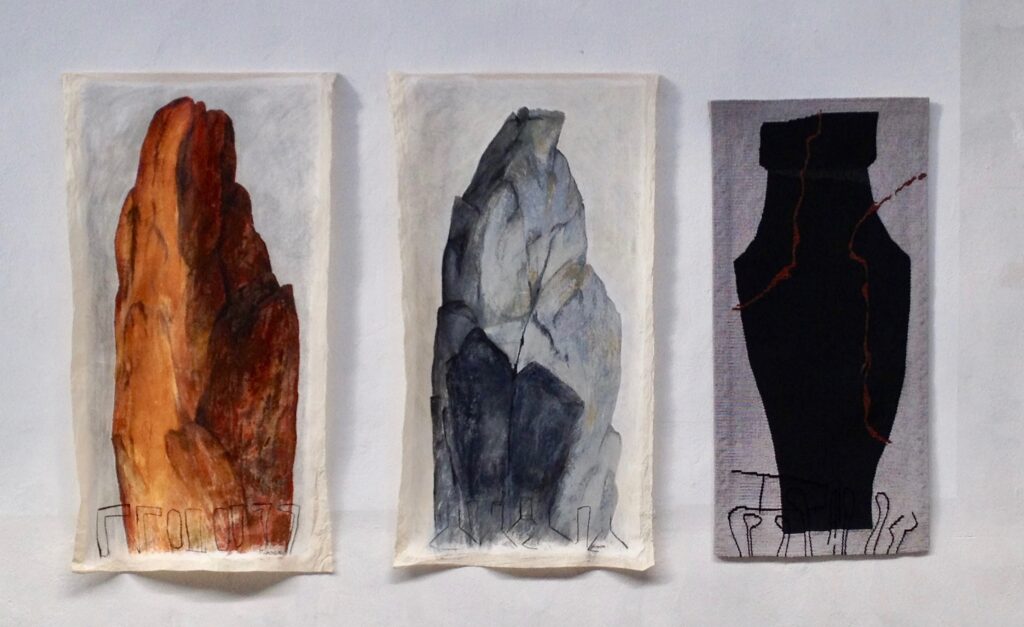
Déplacement, 220 x 150cm triptych – pastel on gessoed cotton and woven tapestry (wool, cotton)
As my blog is about artists in the Drôme mention must be made of two artists from our Department who enjoy international recognition and whose paintings have often been reproduced in the form of tapestries: Bernard Cathelin and Pierre Boncompain. I was told that a tapestry of Cathelin’s work decorates one of the most famous restaurants in France, La Tour d’Argent in Paris but many have also been exhibited abroad, notably in the US, Italy, Canada and Japan. As for Boncompain, his lusciously coloured tapestries can be found in Japan, China and the US. These tapestries only bear the name of the artist who has designed them and not that of the weaver whose arduous task is to replicate them, often weaving up to 6 tapestries of the same painting. However, Sally’s art, which is what this blog is about, is all the more interesting due to the fact that she is both designer and weaver.
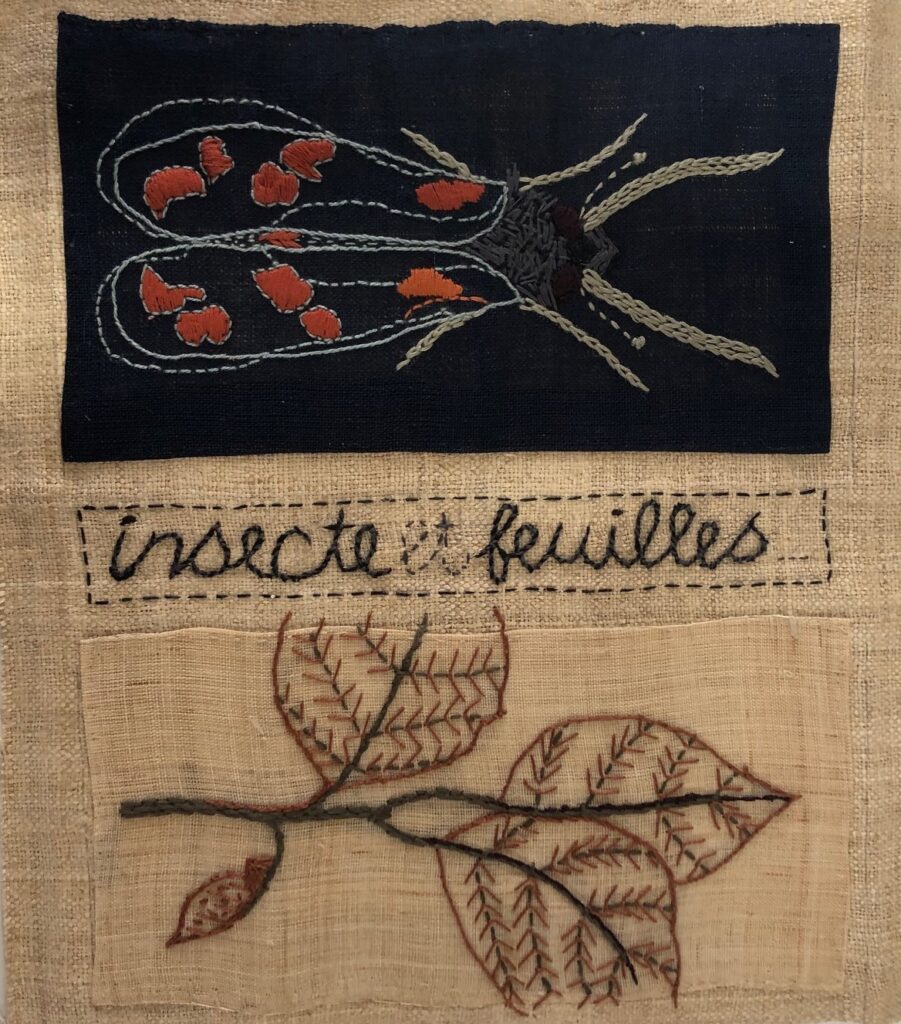
Insect and leaves, 30 x 40cms – Embroidery and applique, cotton and silk, natural fibres
I asked Sally for her definition of textile art and she answered “It is the creation and making of an art work using fibre as the medium. Fibre in this case comprises a broad palette of materials: cotton, silk, linen, wool, etc. but also paper and synthetic materials. The techniques, in my case, are high warp tapestry weaving, embroidery and appliqué. My work is decorative not functional or practical and all the pieces I create and make are for decorative purposes to be viewed as paintings.” As Sally made no mention of it in her definition, I also wanted to know whether her work contained an emotional message? “Yes, there is a story behind every piece I create.” In other words, in addition to being decorative like my kilims Sally’s work has emotional content, which most certainly qualifies them, in my opinion, as pieces of art.
I also enquired whether there were particular difficulties to be overcome when weaving a tapestry. “Weaving a tapestry is a slow, time-consuming and almost meditative process. Unlike painting it is a sequential process meaning one can only work from bottom to top and within that constraint there are others that govern the direction of the weaving. Tapestry weaving, by the way, and embroidery are also appropriate mediums for a traveller as they can in theory both be done on the move.”
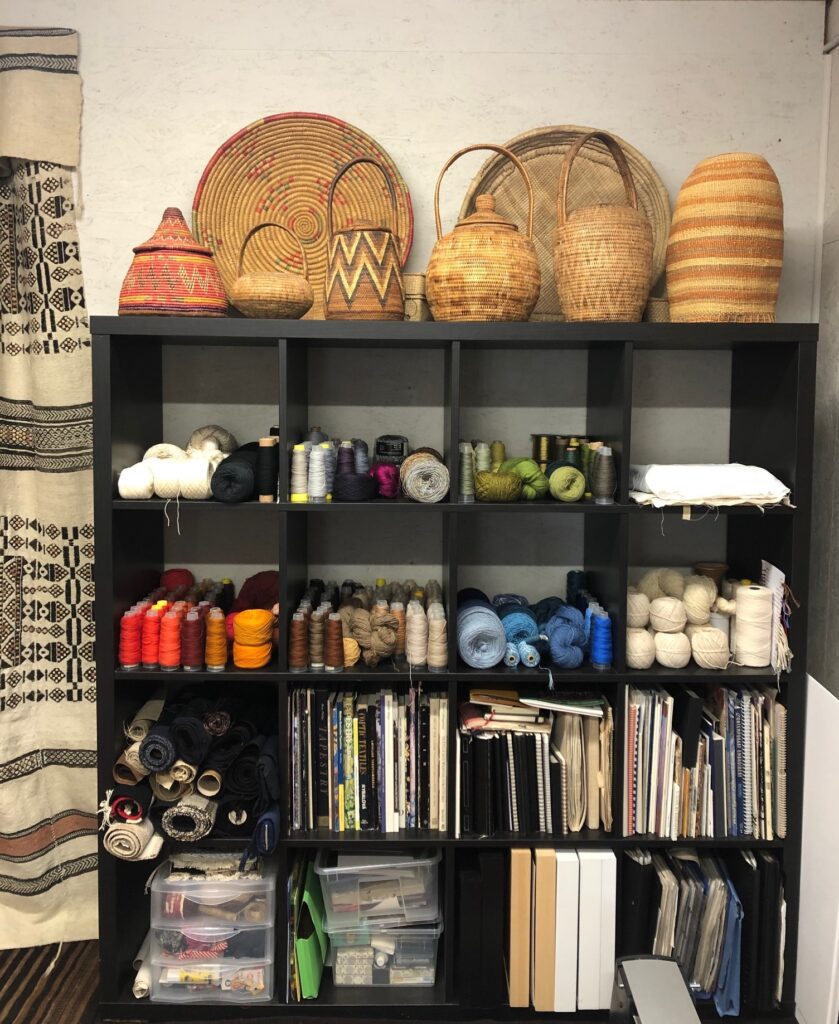
The stock of wool, linen, and cotton for weaving in Sally’s studio
Sally Brokensha grew up in Australia in an environment where art mattered. Her father was an oil company executive who, at the age of 45, changed the course of his life to become an anthropologist spending time in the field researching with the Pitjantjatjara aboriginal people. At the same time, he established the well-known Argyle Arts Centre in Sydney. Sally’s brother was an esteemed professional photographer in London, Sydney and Paris and her sister is a gilder and an interior decorator. Curiosity about other places and cultures is therefore most likely inherited and runs through Sally’s veins for besides being an artist she has been a life-long globetrotter.
After gaining a diploma in textile design and printing at a Sydney Art School, Sally’s life unfolded like a whirlwind of travels and activities, many of the latter being devoted to the practice of her art. How many countries has she visited? When I asked her she reeled them off without any particular order: “ Various States in Australia of course, Dominican Republic, Egypt, England, France, Scotland, Denmark, Indonesia, Cambodia, Vietnam, Laos, Sultanate of Oman, Yemen, Japan, Peru, Surinam, Paraguay, St. Vincent and the Grenadines,” adding that in just one year she had once taken more than 60 plane flights! Among the travels related to her weaving practice Sally spent two years in the Sultanate of Oman with a view of improving the spinning and weaving skills of indigenous Bedu women thereby providing them with means to increase their earnings. She led a similar project with the same aim in Yemen on behalf of The International Labour Organisation, ILO, where she trained urban-based women and girls in embroidery and weaving. Besides these educational activities training others, Sally never ceased to develop her own know-how or to hold successful exhibitions. In Denmark she obtained a diploma in traditional weaving methods and natural dyeing, and in Japan where she spent nine months she studied “Kasuri” which is an extremely difficult tying and dyeing technique which prevents the dye from penetrating the woven tissue.
For nine years Sally put a hold on her weaving activities during which she obtained a Master’s Degree in International Development, after which for three years she managed a programme in the development sector based in Lima, Peru.
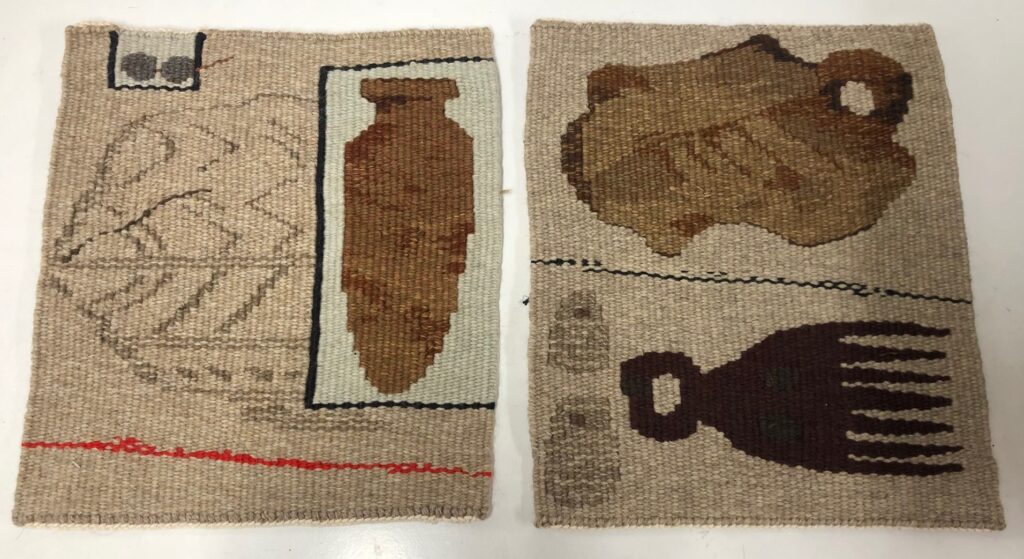
Two tapestries from a series of ‘archaeological finds’ 20 x 25 cm
It was during this period in her life that Sally, having visited and resided in so many different countries, came to realise that she felt more at home in Europe than anywhere else. She moved back to France where she had previously spent some time, taking up weaving and exhibiting her work again. Since 2015 Sally is a resident of Pont-de-Barret where she has her studio.
Reflecting on Sally’s uncommon life path I wondered whether for an artist living in other places and being an expat loosens the imagination, frees them from being bogged down by the cultural climate and constraints of their homeland. Who knows? Be that as it may be, it seems obvious to me, that having been exposed, as Sally has, to other cultures it necessarily affects the art she makes. Like many textile practitioners with a passion for the medium, she is extremely proud of her wonderful collection of textiles as well as an incredible number of ethnic hats many of which were showcased in her successful exhibition Le Cabinet de Curiosités d’une Voyageuse last year in Le Poët Laval.
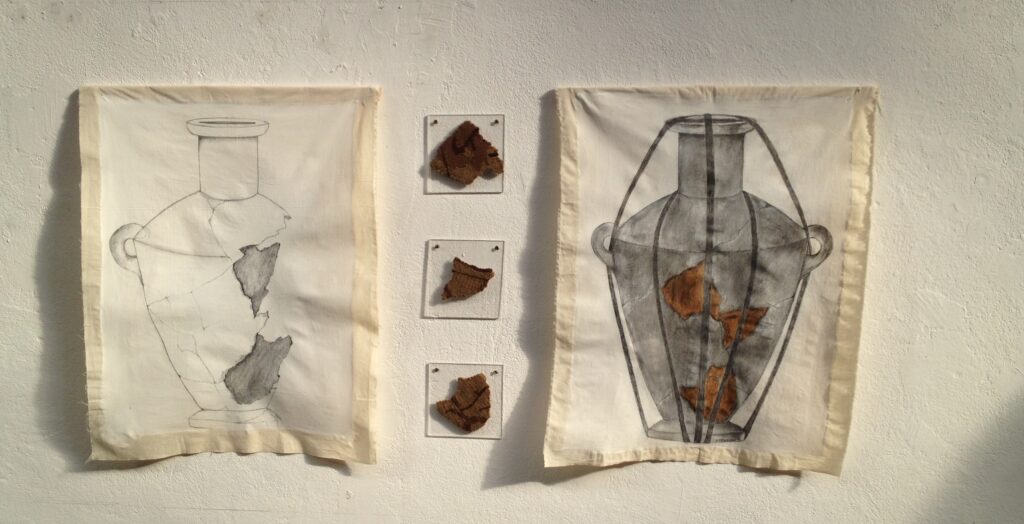
Restoration- Pencil on gessoed cotton fabric with tapestry woven fragments
I am happy and grateful that Sally has taken the time to share some of her experiences with me and I look forward to visiting the exhibition she is now preparing for next year.
Posted in: Art
